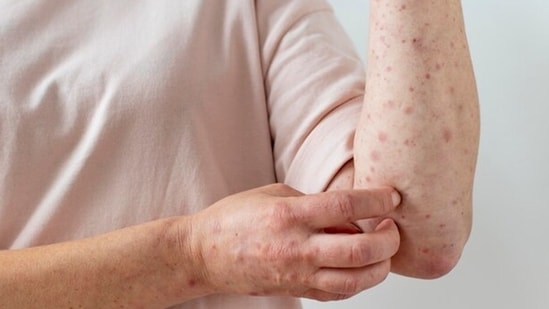Infection
World AIDS Day 2023: How AIDS affects your skin; measures to prevent infections
People with AIDS are susceptible to various skin conditions due to their compromised immunity. Here’s how AIDS affects your skin. Know preventive measures.
HIV/AIDS can make you susceptible to diseases and infections due to weakened immune system and this can include skin disorders. Skin infections in HIV/AIDS patients can be caused by bacteria, fungus, virus and other germ or the treatment they are getting to manage the condition. HIV (human immunodeficiency virus) is a virus that attacks the body’s immune system and if not treated, it can lead to AIDS (acquired immunodeficiency syndrome). While HIV cannot be cured, it can be managed in order to live a long and healthy life. The only way to know if you have HIV is through testing. Antibody tests, antigen/antibody tests, and nucleic acid tests (NAT) are the three main HIV tests. According to John Hopkins Medicine, topical steroid treatment (lotions or creams put right on the skin) and managing it with antiretroviral drugs can help provide relief. Antiretroviral drugs can help prevent and manage some of these types of skin conditions. (Also read | World can end AIDS by 2030, says UN agency)
“Acquired Immunodeficiency Syndrome (AIDS) is a condition caused by the Human Immunodeficiency Virus (HIV), which attacks the immune system, leading to a weakened defense against infections. The skin, being the body’s largest organ, often reflects the overall health of the immune system. Individuals with AIDS are particularly susceptible to various skin conditions due to their compromised immunity,” says Dr Rinky Kapoor, Consultant Dermatologist, Cosmetic Dermatologist & Dermato-Surgeon, The Esthetic Clinics.
“Seborrhoeic dermatitis is one of the earliest and most common manifestation in which the patient presents with itching and widespread and excessive greasy flakes over scalp (dandruff), face and skin folds like underarms and groin. They can also be at risk of Herpes zoster (shingles), which presents with grouped painful blisters associated with pus, erosions and crusting localised on one side of the body. This is caused by reactivation of the chicken pox virus due to immunosuppression, which lies dormant in nerves of the skin after infection during childhood. In AIDS, shingles is more widespread, crossing over to the other side involving large areas and lasting longer than usual,” says Dr Aayush Gupta, Associate Professor and Consultant Dermatologist.
Dr Rinky Kapoor shares common skin infections that can affect HIV/AIDS patients:
1. Candidiasis
One common dermatological manifestation is fungal infections, such as candidiasis. Candida, a yeast-like fungus, can cause infections in moist areas like the mouth, throat, and genital region. In individuals with AIDS, these infections can be persistent and challenging to treat.
2. Herpes simplex virus
Viral infections are also prevalent, with herpes simplex virus (HSV) causing oral and genital herpes. Lesions may be more severe and recurrent in individuals with AIDS, requiring antiviral medications for management.
3. Bacterial infections
Bacterial infections, including staphylococcal and streptococcal infections, can lead to cellulitis or boils. These skin conditions may be more aggressive in individuals with compromised immune systems, necessitating prompt medical attention.
“Due to reduced immunity, bacterial skin infections also become more common and recurrent leading to painful wounds with pus discharge, including tuberculosis of the skin which presents with non-healing deep wounds and ulcers,” says Dr Gupta.
4. Seborrheic dermatitis
Furthermore, seborrheic dermatitis, characterized by red, itchy, and flaky skin, is common in AIDS patients. It often affects the scalp, face, and chest.
5. Kaposi’s sarcoma
Kaposi’s sarcoma, a cancer linked to human herpesvirus-8 (HHV-8), presents as skin lesions that are typically purplish in colour. This condition is more prevalent in individuals with AIDS, emphasizing the intricate relationship between immunosuppression and certain malignancies.
6. Scabies
Scabies is another common manifestation caused by infestation with a mite, presenting as small bumps and scratches over finger webs, underarms, abdomen, groin, thighs genitals and buttocks. Itching which is intense at night is typical.
“Scabies is another common manifestation caused by infestation with a mite, presenting as small bumps and scratches over finger webs, underarms, abdomen, groin, thighs genitals and buttocks. Itching which is intense at night is typical,” says Dr Gupta.
“Other viral infections that are common in AIDS include Molluscum contagiosum which presents as multiple painless skin coloured dome shaped bumps and viral warts which present as multiple painless, finger like rough projections over the body. HIV is also associated with inflammatory conditions causing itchy red bumps over the limb and trunk, the cause of which is poorly understood and thought to be due to some kind of hypersensitivity reaction. All these manifestations can serve as clues for early diagnosis facilitating early intervention and better disease outcome,” says Dr Gupta.
Prevention tips
“Regular skin checks are crucial for individuals with AIDS to detect any abnormalities early. Seeking medical advice promptly allows for timely intervention, preventing the progression of these conditions. Dermatological care, coupled with antiretroviral therapy to manage HIV, plays a vital role in enhancing the quality of life for individuals affected by AIDS,” concludes Dr Kapoor.
Catch your daily dose of Fashion, Health, Festivals, Travel, Relationship, Recipe and all the other Latest Lifestyle News on Hindustan Times Website and APPs
- World Aids Day
- Hiv Virus

